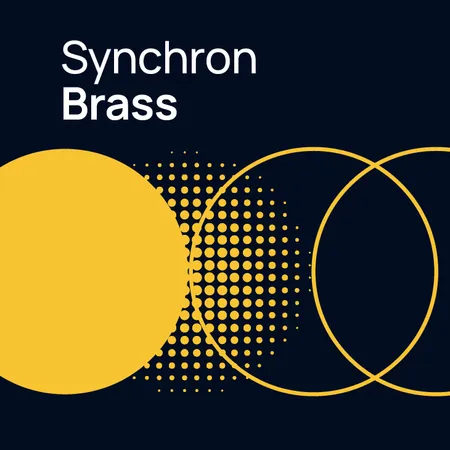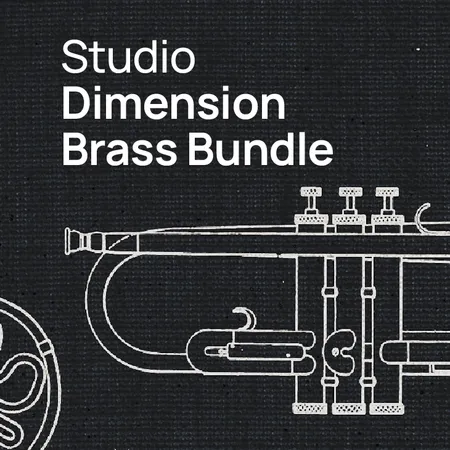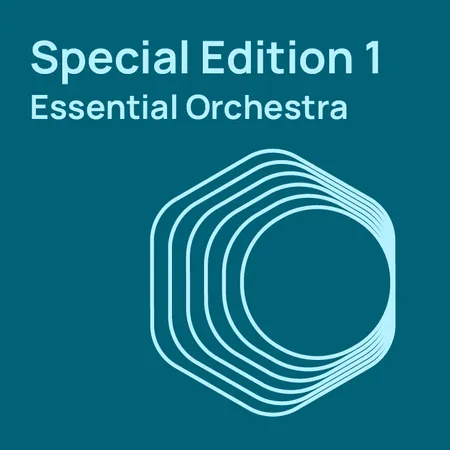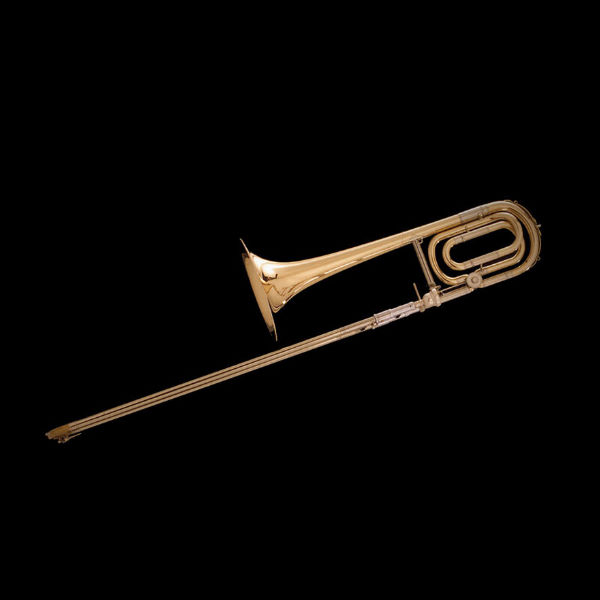
Name: Tenor trombone in Bb
Spelling
German: Tenorposaune
French: trombone
Italian: trombone in Si b
Classification: Aerophone, brass wind instrument
Material: Mainly brass, often gold brass; nickel silver (inner and outer slides)
Mouthpiece: Cup-shaped mouthpiece
Tubing: Length approx. 269 cm, mostly cylindrical
Bore: Narrow, inner diameter approx. 12.6-13.9 mm
Slide
Bell: Rim diameter 20.5-22 cm
The trombone consists of three parts: the bell with the tuning slide; the inner slide, open at the top and bottom with the mouthpipe and mouthpiece attached to its top part and the bell attached to its bottom; and the U-shaped movable outer slide, which connects the two open-ended parallel tubes of the inner slide. Slide stays strengthen the two sets of parallel tubes. The main (inner) tube is held with the left hand and the slide shifted by the right, thus altering the tube length. It is the slide that distinguishes the trombone, the oldest brass wind instrument with a chromatic scale, from all the other brass instruments.
In France somewhat smaller bores are used than in Germany and North America, and smaller bores are also generally preferred for solo performances.
Discover our Trombones
Trombones and trumpets evolved from the medieval buisine, a brass wind instrument that originated in southern Italy in the 11th century and took two principal forms: the first was a conical tube that flared as the length increased, ending in a deep bell; the tubing was curved, like an animal horn, and could even become coiled in longer versions. It is this instrument from which the French horn and other instruments of the saxhorn and flugelhorn families evolved. The second form consisted of a long cylindrical tube (unvarying bore size), upon which a broad, shallow bell was mounted. This was the forerunner of trumpets and trombones.
The modern trombone originated in Burgundy in the middle of the 15th century. Efforts to shorten the slide lengths of the S-shaped slide trumpet resulted in the invention of the U-shaped slide. This simple construction has remained unchanged to this day: every shift of the slide, which is composed of two parallel cylindrical tubes, doubled the total length of tubing, i.e., the length of the slide was halved between each position. This made it possible not only to play as quickly as on the trumpet, but also to reach the tenor and bass registers. In only a few decades the trombone gained such popularity in Europe that along with the bombarde, shawm (reed instruments of the period) and cornett it became standard in court orchestras around 1500, for example at the court of Emperor Maximilian I.
By the end of the 15th century, Nuremberg in Germany had already become an important center for the construction of trombones. Unlike today’s instruments, these early trombones had a very slender sound thanks to their smaller bore and the only very slight taper toward the bell, resulting in a sound which could swell to resounding magnificence in the trombone chorus.
Its slender sound, agility and ability permanently to adjust its intonation - which are all properties of the human voice - meant that in the 16th and 17th centuries the trombone was ideally suited for accompanying choral music. At the beginning of the 17th century the slide system was added which is still used today. Following on from this, whole instrument families were constructed, consisting of soprano trombones in Bb and C, alto trombones in F and Eb, a tenor trombone in Bb, a bass trombone in F and Eb and a contrabass trombone in Bb. Giovanni Gabrieli (1557-1612), the first composer of purely instrumental pieces with specific instructions as to their instrumentation, calls for the trombone family in his "Symphoniae Sacrae". Heinrich Schütz (1585-1672) and J. S. Bach, in his cantatas, also wrote four-part passages for trombones, sometimes in unison with the choir voices (colla parte) and sometimes contrasting with them.
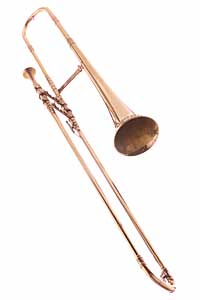
Baroque trombone, Meinl & Lauber, Geretsried, Germany, 1972. Copy of a trombone by S. Hainlein (Musikinstrumentenmuseum Schloss Kremsegg, Austria, Streitwieser collection)
The timbre of the baroque trombone differs from that of today’s instrument: the narrower bore produced a thinner sound; the narrower bell was more conducive to the production of the higher partials, while the thicker walls of the tubing prevented a shrill blare. In keeping with the sound ideal it was the instrument’s task to combine with the voices, the woodwinds or the strings: thus the bass trombone was used in combination with the violins and cellos or the viola and alto trombone. Trombones also played the cantus firmus or the thorough-bass in a brass ensemble together with the trumpets or cornets.
During the 18th century the soprano trombone’s role as a melodic instrument was taken over by the cornett and the trumpet - although Mozart (1756-1791) stills calls for the soprano trombone in his Mass in C minor KV 427 (1783) - and in the 19th century it disappeared from orchestral music altogether. The alto trombone remained in use until the middle of the 19th century and was part of the characteristic trio of trombones - alto, tenor and bass - which still held its place as standard in the Romantic orchestra after the alto trombone had generally been superseded by the tenor.
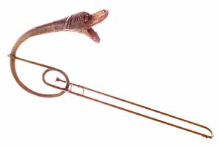
Tenor trombone, silver-plated slide: America, end of 19th century, brass dragon-head bell: France, ca. 1820/30 (Musikinstrumentenmuseum Schloss Kremsegg, Austria, Streitwieser collection)
For nearly a century the trombone had been given fairly humble roles to play - solemn passages, chords, sustained notes, colla parte with the voices. Only in church music, in which it had also been used as a solo instrument, had it enjoyed any prominence. But toward the end of the 18th century the trombone began to gain new importance.
The development of the valve system at the beginning of the 19th century meant that trumpets and horns could now play a full chromatic scale, thus improving the standing of brass instruments in the orchestra in relation to the strings. The brass instruments’ new tasks also resulted in new demands on the trombones. The broadening of the bore and bell gave the trombone a much richer and more metallic sound, allying it more to the trumpet, while the French horn, with its more mellow sound, became more and more closely associated with the woodwinds.
From 1830 valve trombones, constructed primarily on account of their agility, became increasingly popular, and were used particularly in Italy and in German military bands. Although Verdi included several extremely challenging passages for valve trombone in his operas, it failed to gain widespread acceptance, principally because it did not possess the characteristic glissando of the slide trombone.
In the symphony and opera orchestras of the 19th century the standard orchestration for trombones was three-part, usually two tenor trombones and a tenor-bass. A fourth instrument was often added to reinforce the bass in unison , to play the bass part an octave deeper or to play the bass part on its own. The fact that several instruments shared this task during the 19th century without a satisfactory solution being found reveals an instrumentation problem which has often been the subject of discourses in instrumentation theory: the ophicleide (a bugle with keys), which functioned as a bass instrument to the trombones, had a rough and imperfect sound and was later replaced by the tuba, which, however, has a different timbre from the trombones. A solution was later found with the construction of the contrabass trombone.

Valve trombone in Bb, F. Besson, London (Musikinstrumentenmuseum Schloss Kremsegg, Austria, Streitwieser collection)
In 19th century orchestras trombones were used principally for the following tasks: harmonic/chordal fundament, melody (solo and in combination with other instruments), bass parts together with the double-basses, reinforcement of the vocal parts and reinforcement of sound. The trombone also gained importance as a solo instrument (Rimsky-Korsakov: "Concerto for Trombone and Wind Orchestra").
While the four-part trombone section was maintained in 20th century orchestras, a whole new range of playing techniques was introduced: vibrato, glissando, triple and flutter tonguing. The instrument’s flexibility meant that it was soon playing a leading role as a solo jazz instrument, since the intonation required for jazz was easy to play on it.
In the course of its history the trombone has become increasingly versatile and its stylistic possibilities have grown to the point where today the instrument is no longer subject to any stylistic constraints.
Notation in the tenor and bass clefs, no transposition. All three trombone parts are usually written in tenor clef for the upper register and in bass clef for the lower.
Although the tenor trombone is tuned to Bb1, music written for it does not take this into account: the sound is as written. The instruments in the trombone family are tuned to different pitches - the alto trombone is in Eb2, the bass trombone in F1, the contrabass trombone in Bb0. This means that the musician must use a different fingering whenever he changes instruments. The tenor-bass trombone’s fingering is particularly challenging, because the fundamental pitch can be altered from Bb1 to F1 by means of a fourth-valve (or to Eb1 by means of a fifth-valve).
Range of the tenor trombone: E2 - F5
As a rule notes from the 2nd natural are used, so the 2nd natural of the 7th position makes E2 the lowest note. Overblowing is generally used up to the 8th, 9th or 10th natural. Only very proficient players can overblow as far as the 12th natural.
In the 1st position the tube is at its shortest - and therefore natural - length (about 290 cm), the longest length (about 410 cm) being reached in the 7th position. This difference of 120 cm means that the trombonist has to move the slide over a distance of about 60 cm. It is therefore very difficult to play fast passages in distant positions accurately.
For each note, the trombonist tries to choose the position that requires the lowest natural - naturals beyond the 8th are seldom used in the lower positions, since low naturals respond better from a higher position. For example, F4 can be played as the 6th natural in the 1st position or as the 8th natural in the 6th position. If possible, players choose the first fingering.
A second criterion for the choice of position is the similarity of the sound quality, which is also influenced by big differences in the degree of overblowing.
Between the pedal in the 1st position (Bb1) and the 2nd natural of the 7th position there is a gap which can only be filled with the help of a fourth-valve (F valve) or fifth-valve (Eb valve) as used on the tenor-bass trombone. Modern orchestral compositions call for all seven pedals, and on modern trombones with their wider bore these speak relatively well. Pedals were discovered in the 1830s and were originally very rarely asked for because they were so hard to play. Their tone quality was often described as rough and without substance. However, their dark and metallic sound then prompted composers such as Berlioz (Requiem: Hostias), Messiaen (Les Couleurs de la Cité Celeste) and Alban Berg (Wozzeck, Act 2) to call for pedals.
The Vienna Symphonic Library decided not to include a sample of the pedals of the tenor trombone because notes of this type can also be played in superlative quality on the bass and contrabass trombone.
Can be performed at a speed of MM 120 (= 4 sixteenths per quarter note = 120). The musician articulates a T T T T.
A microtonal pitch fluctuation possible in passages at any tempo and at all dynamic levels; vibrato can be played in virtually any context, from pp to ff and from slow to fast.
Sforzando
Forced, short attack followed by a rapid reduction in tone intensity.
Sforzandissimo
Forced, short attack with continuance of tone intensity.
Fortepiano
Rapid dynamic reduction from forte to piano.
Can be performed up to MM 144 (= 4 // per quarter note = 144). Articulation: TKTK
EVery fast. Articulation: TTKTTK
Articulation: an R rolled against the front of the mouth.
All the missing notes can be sounded by using the slide. This practice first emerged in America at the turn of the 20th century and has slowly found its way into symphonic orchestral practice by way of jazz.
This is possible both ascending and descending. The maximum extent is a diminished fifth (the interval between the 1st and 7th positions). The glissando can be played on every partial, although it is not possible to change the partial while playing it.
Very difficult, is not called for.
While the slide is descending (over a maximum of three positions), the glissando is moving upward in contrary motion. This is very difficult to perform.
On the trombone, the trill is one of the less refined sounds.
Produced by rapid alteration of lip pressure and only possible between two neighboring partials of the same series. Only whole tone trills between D4 and D5 are possible.
Rapid alternation between two neighboring positions. The intonation is rather wayward and only possible as far as the 4th or 5th position. Half step trill without rearticulation.
Makes the sound more precise in forte passages and has subtle effects on pianissimo playing.
Because the seven positions are achieved by sliding shifts, each note must be separately articulated to avoid a glissando effect. A seamless legato is therefore possible. Large leaps between positions are difficult, but can be played legato. The legato is at its most complete between the notes of the same series of naturals. Ascending intervals are easier to tie than descending ones.
Each interval of the same series can be played by slurring.
Brassy, brilliant, powerful, overpowering, solid, tense, penetrating, dramatic, hard, full, sinister, soft, round.
The sound of the trombone remains homogeneous throughout its entire range. There are no big differences between the registers such as those found in the clarinet or the bassoon.
Pedals
These sound metallic, grave, dark, distant, focused (not wide like the tuba).
Low register
dark, weighty, dense, somber, threatening when played forte, mysterious and full when played piano. It is used for weighty and portentous themes and as bass in harmony sequences.
Middle register
Metallic sound, mighty, sometimes blaring and heroic when played forte.
Grave, sustaining, full, mysterious in piano. Very short and barely sounded notes through sustained chords.
Upper register
Here the sound becomes more brilliant and can reach sweeping intensity. The mellowness increases. The tenor trombone, now sounding more metallic, more definite and brighter, shares this register with the French horn, which sounds playful and magical.
Brilliance in piano.
At its highest pitch the tenor trombone reaches the trumpet register sounding more substantial and mellower.
Good tonal blend with the other brass instruments.
In unison and in octaves: metallic sound, impression of power.
Good sound combination, makes the trombone sound brighter. Particularly good blend in the lower register.
Overall sound rich and mellow, intensified by the trombones in ff passages. In higher registers the trombone makes the horns sound brighter, the rest of the time the metallic trombone sound is masked by the horns. 1 trombone = 2 horns when the written dynamic levels correspond.
Although it has a different timbre, the tuba is often used as bass to the trombone section. The main reason for this is to produce a full-sounding foundation in tutti passages. The trombone sounds much more compact and focused. The tuba can either be used on its own as bass to the trombones (as a fourth trombone), in octaves, or in unison with the bass trombone. These last combinations are often recommended. The overall effect is one of expansiveness and mellowness. The brightness of the trumpets and trombones is subdued.
The combination of trombones and woodwinds produces a very patchy blend, so homogenous effects cannot really be achieved.
Are heard distinctly as a rule, although blending is good when the trombone is played with a mute.
The bassoon masks the metallic quality of the trombone’s tone, which results in delicate contours in the middle and lower registers and in piano passages. For the reinforcement of sound in tutti passages the octave combination of trombone and low woodwinds serves as the bass.
The combination with strings does not generally produce homogeneity. Trombones play in unison or in octaves with the cellos and double-basses, fleshing out the sound and playing a supporting role. The result is a concentration of the sound. If a trombone bass part is also carried by a double-bass the sound is projected more effectively.
The trombone symbolizes the hereafter, the supernatural, hell and the underworld. Its powerful sound is supposed to conjure up images of the terror and unknown dimensions of these realms of darkness. Particularly in requiems (Mozart, Berlioz, …) the trombone section, often large, is assigned the role of evoking the audience’s fear of crossing over to the hereafter in the Dies irae and Tuba mirum. The symbolism is therefore religious, as it has been in opera, too, since Monteverdi (Weber's "Freischütz").
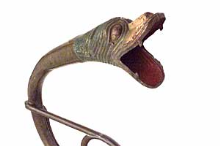
Tenor trombone, silver-plated slide: America, end of 19th century, brass dragon-head bell: France, ca. 1820/30 (Musikinstrumentenmuseum Schloss Kremsegg, Austria, Streitwieser collection)
The increase in the number of playing techniques in the 20th century, partly inspired by jazz, enabled the trombone to take on entirely new roles in very “secular” contexts. New effects such as glissando, flutter tonguing and the use of various different mutes endowed the instrument with possibilities for expression ranging from solo narration to parody and burlesque. It is this aspect of the trombone that is being developed further in more modern works.
Ludwig van Beethoven
- Symphonies no. 5 (1808), 6 (1808), 9 (1824)
Hector Berlioz
- Grande Messe des Morts (1837)
G. C. Wagenseil
- Concerto
Michael Haydn
- Divertimento in D
J. G. Albrechtsberger
- Concerto in B-flat (1769)
Ferdinand David
- Concerto in E-flat, op.4
Nikolai Rimsky-Korsakov
- Concerto in B-flat major for trombone and military band (1877)
Ernest Bloch
- Symphony (1956)
Darius Milhaud
- Concerto d'Hiver (1953)
Paul Hindemith
- Concert music for strings and brass, op.50 (1930)
Iannis Xenakis
- Pithoprakta (1956)
Giovanni Gabrieli
- Sonata piano e forte (1597/1615)
Igor Stravinsky
- L’histoire du soldat (1918)
- Octet (1923)
Anton Webern
- Konzert, op.24 (1934)
Edgard Varèse
- Octandre (1923)
Hans Werner Henze
- Concerto per il Marigny (1956)
Aaron Copland
- Fanfare for the common man (1943)
Johann Nepomuk David
- Nun freut Euch, liebe Christen g'mein (1937)
Cesar Bresgen
- Festlicher Ruf, op.71/1
Eugène Bozza
- Suite (1967), Quintett
Goffredo Petrassi
- Musica di ottone (1963)
Charles Ives
- Processional: Let there be light
Paul Hindemith
- Plöner Musiktag Nr.1, Morgenmusik (1932)
- Ludwig van Beethoven
- 3 aequale (1812)
- Anton Bruckner
- Aequale (1847)
- Georg Philipp Telemann
- Six sonatas
Eugène Bozza
- Ballade (1944)
- Hommage a Bach (1957)
- Ciaccona (1967)
Paul Hindemith
- Sonata (1941)
John Cage
- Solo for sliding trombone
Leonard Bernstein
- Elegy for Mippy II (1950)
Luciano Berio
- Sequenza V (1968)
Vinko Globokar
- Discours (1968)
On this page
- History
- 15th century - the birth of the trombone
- The baroque trombone - delicate sound combinations
- Classical and Romantic music - the three-part trombone section establishes itself
- 20th century - a wide range of playing techniques
- Notation
- Range
- Sound production
- Playing Techniques
- Single Tonguing
- Vibrato
- Sforzato
- Double tonguing
- Triple tonguing
- Flutter tonguing
- Glissando
- Trills
- Mute
- Runs
- Slurs
- Sound characteristics
- Sound Combinations
- Trombone + brass instruments
- Trombone + woodwinds
- Trombone + strings
- Symbolism
- Repertoire (selection)
- Symphonic works
- Solo trombone and orchestra
- Chamber music
- Wind ensemble with trombone
- Ensemble of five instruments with trombone
- 4 trombones
- 3 trombones
- 2 trombones
- Trombone and piano
- Trombone solo
